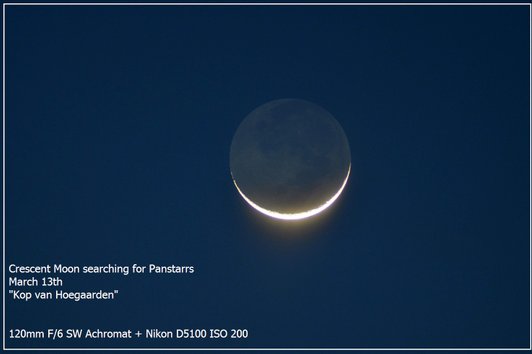Drogenberg
Astrophotography
(c) Joost Verheyden
Hoegaarden, Belgium
EQUIPMENT REVIEW SKYWATCHER STARTRAVEL 120mm F/5 ACHROMAT
All reviews represent my personal opinion after extended usage of the material - I have no connections to any vendor or brand.

ASTROPHOTOGRAPHY WITH THE SKYWATCHER TRAVELSTAR
The image to the right is taken with this telescope. Ofcourse this is not a telescope that was designed for astrophotography. Ofcourse this scope gives blue violet halo's on long exposures.
The trick is to reduce the objective to a 80mm lens, by making a small cardboard mask. That's excatly what I did to makepictures acceptable with this telescope. It becomes an 80mm F 7,5 telelens. To reduce the color fringe even more I used filters like the IDAS LPS D1 filter from HUTECH or the Baader Semi-APO filter.
The results are imho very very acceptable. Especially if you start to compare this 150€ scope with apochromatic scopes of 80mm diameter F6,5 for 800€.
The picture below is a crop of the picture to the right. Stars are white, no halos.
Image to the right (Black/White) as a comparison is taken with a mirror system (Schmidt Newtonian) 200mm F/4 with an ATIK 16HR CCD camera. Allthough the stars are a bit feathered (due to the IDAS filter which works not as good with F/4 focal ratios) they are smaller when compared to the pictures above. Question is: in how far is this an objection? The SN200 F/4 is already a more expensive and more fragile device (collimation, dew, front corrector, balans ).
Below: color fringe in the Travelstar with different objective reductions and different filters applied. Some with the FLT110 or TMB 90mm Apochromatic telescopes in comparison.
The SkyWatcher 120mm F/5 Travelstar is an achromatic refractor. It has a Doublet lens in the front.
I have been using this telescope for many years as a real do-it-all workhorse. It delivered very nice images of the solar system, of the Moon and also the Sun using a Mylar solar screen.
It was and still is a very high cost/value telescope because for only 150/200 € (secondhand) you will buy a lot of fun observing. The low price makes it also far more usable at star parties, observing with children, towing it around on travel, bringiong it to field observing sessions. No fear of damaging a priceless instrument. No fear of loosing collimation.
The short focal length can be easily extended using a barlow. Even on planets like Jupiter, surprising details come out. The Red SPot and the Equatorial bands can be observed as well as the 4 Galilean moons. Mars will show a polar ice cap. Saturn shows his rings and Venus like Mercury will show the lunar phases.
In addition you can start making a career in astrophotography.
So why did I sell it? Very easy: I needed to sell because I wanted to fund a new telescope. I replaced this one with the TS65APO-Q telescope. Because of my higher demands in image quality for imaging I needed to switch to a Apochromatic telescope.
However I can imaging buying one again for mobile and public use.

Picture above: the sun through the Travelstar reduced in diameter to 80mm for sharpness. A Herschell wedge from Baader was used.
(c) Copyright 2014 Some Rights Reserved: Attribution-NonCommercial-NoDerivs. To use any of these pictures commercially contact: pictures(at)drogenberg.be or use the contact form.

.jpg?etag=%22W%2F%22%20%228fd5e-5620cc82%22&sourceContentType=image%2Fjpeg&ignoreAspectRatio&resize=594%2B1157&extract=0%2B0%2B589%2B1157&quality=85)

